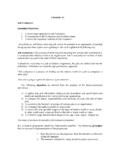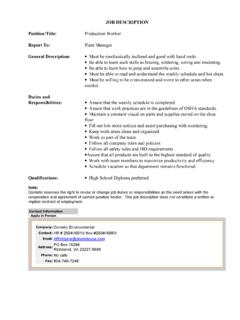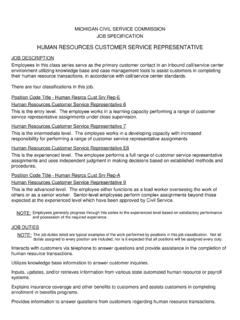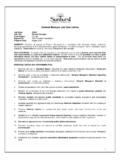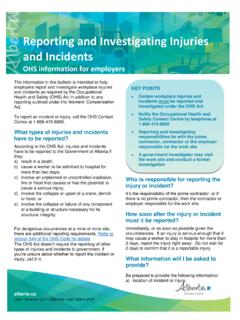Transcription of Lesson: 9 Job Analysis - PSNA CET
1 lesson : 9 job analysis Contents: o Definition o 6 Steps in Job Analysis o job description Vs Job specification o Elements of Job Analysis o Types of info. gathered o Method of collecting Job Analysis Data o Impact of Behavioral on Job Analysis Dear students, In this lesson we will be discussing the nature and use of Job Analysis . Let us first try to understand what is job Analysis . You must understand that Job Analysis provides the basis for determining what types of information should be obtained from the applicant, from previous employers, and from other sources. Even though many companies are laying off substantial portions of their workforces, employee selection is a vital part of HRM.
2 Personnel selection is important in the building of a productive workforce. Determining the qualifications of job candidates requires that as much information as possible be obtained from the candidates and other sources. It is important for you to understand that the information that is collected should be relevant to the job and sufficiently reliable and valid. HR practitioners should have an understanding of job requirements to permit an Analysis of application forms, employment tests, interviews, and reference checks of individual candidates. Following definitions will help you to understand the concept of job Analysis better: A defined data collection and Analysis procedure through which information about job tasks and job requirements are obtained.
3 Job Analysis is the procedure for determining the duties and skill requirements of a job and the kind of person who should be hired for it. Organizations consist of positions that have to be staffed. Job Analysis is the procedure through which you determine the duties of these positions and the characteristics of the people who should be hired for them .The Analysis produces information on job requirements, which is then used for developing job descriptions (what the job entails) and job specifications (what kind of people to hire for the job). Now let us go through the 6 Steps In Job Analysis Develop job description / Job Specification 6 Review information with incumbents 5 Collect data to analyse job 4 Review background information 2 Identify how information will be used 1 Select representative positions to
4 Analyse 3 Go through the following six steps in doing a job Analysis . They will make the concept clear to you. Step 1 Identify the use to which the information will be put, since this will determine the types of data you collect and how you collect them. Some data collection techniques like interviewing the employee and asking what the job entails and what his responsibilities are - are good for writing job descriptions and selecting employees for the job. Step 2 Review relevant background information such as organization charts, process charts, and job descriptions . Organization charts show how the job in question relates to other jobs and where it fits in the overall organization.
5 The chart should identify the title of each position and, by means of its interconnecting lines, show who reports to whom and with whom the job incumbent is expected to communicate. Step 3 Select representative positions to be analyzed. This is done when many similar jobs are to be analyzed and it is too time-consuming to analyze, say, the jobs of all assembly workers. Step 4 Next actually analyze the job by collecting data on job activities, required employee behaviors, working conditions, and human traits and abilities needed to perform the job. For this, you would use one or more of the job Analysis techniques explained in this lesson .
6 Step 5 Review the information with job incumbents. The job Analysis information should be verified with the worker performing the job and with his or her immediate supervisor. This will help to confirm that the information is factually correct and complete. This "review" step can also help gain the employee's acceptance of the job Analysis data and conclusions by giving that person a chance to review and modify your description of his or her job activities. Step 6 Develop a job description and job specification. A job description and a job specification are usually two concrete products of the job Analysis . The job description is a, written statement that describes the activities and responsibilities of the job, as well as important features of the job such as working conditions and safety hazards.
7 The job specification summarizes the personal qualities, skills, and background required for getting the job done; it may be either a separate document or on the same document as the job description . It is very important to understand why is Job Analysis required: What is Job Analysis - job Analysis is obtaining information about jobs. Why is Job Analysis important - Without sufficient knowledge of what employees do, organizations cannot develop other human resource practices and procedures. Job Analysis is a systematic procedure for studying jobs to determine their various elements and requirements. The job Analysis for a particular position typically consists of two parts.
8 O A job description is a list of the elements that make up a particular job. o A job specification is a list of the qualifications required to perform particular job. job description Vs. Job Specification o job description - written narrative describing activities performed on a job; includes information about equipment used and working conditions under which job is performed. o Job Specification - outlines specific skills, knowledge, abilities, physical and personal characteristics necessary to perform a job - What about physical and personal characteristics? Strength, patience, intestinal fortitude, risk-taker. It is essential for you to understand that Job Analysis helps to find information about the following: Work activities.
9 Information is usually collected on the actual work activities performed, such as cleaning, selling, teaching, or painting. Such a list may also indicate how, why, and when the worker performs each activity. Human behaviors. Information on human behaviors like sensing, communicating, decision-making, and writing may also be collected. Included here would be information regarding human job demands such as lifting weights, walking long distances, and so on. Machines, tools, equipment, and work aids used. Included here would be information regarding products made, materials processed, knowledge dealt with or applied (such as finance or law), and services rendered (such as counseling or repairing) Performance standards.
10 Information is also collected regarding performance standards (in terms of quantity, quality, or speed for each job duty, for instance) by which an employee in this job will be evaluated. Job context. Included here is information about such matters as physical working conditions, work schedule, and the organizational and social context-for instance, in terms of the number of people with whom the employee would normally have to interact. Also included here might be information regarding incentives for doing the job. Human requirements. Finally, information is usually compiled regarding human requirements of the job, such as job-related knowledge or skills (education, training, work experience) and required personal attributes (aptitudes, physical characteristics, personality, interests).

